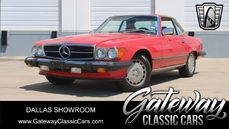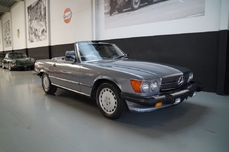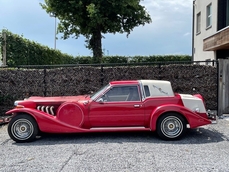Mercedes-Benz 560SL w107 1988
General description :
Very clean car! with original beige leather seats that are still like new! very hard and stainless SL 560 with only 97939 miles attached with a Carfax History report! In the beautiful color combination black with beige leather.
The soft top has signs of wear and should be replaced, these costs + - 600 €. Prtomo Summersale 29900€ ( Exclusief hardtop 1000€)
Model Year 1988
Model 560 SL
Engine 117967 12 039103
Transmission 722313 03 111848
Order Number 0 8 704 03388
Order Location UNITED STATES (USA)
Interior LEATHER - PALOMINO (274)
Paint 1 BLACK (040O)
Paint 2 BLACK (040O)
Paint 5 74
Approx. Build Date 1988-06
Code Description
240 OUTSIDE TEMPERATURE INDICATOR
262 ELIMINATION OF REAR END SPOILER
442 AIRBAG IN STEERING WHEEL
461 INSTRUMENT WITH MILES IND. AND ENGLISH LEGEND
491 U.S. VERSION
506 OUTSIDE REAR VIEW MIRROR, LEFT AND RIGHT, HEATED (ELECTRICALLY ADJUSTABLE ON THE RIGHT)
519 BECKER RADIO MEXICO GRAND PRIX, ELECTRONIC (USA)
524 PAINTWORK - PRESERVATION
531 AUTOMATIC ANTENNA
543 SUN VISOR WITH VANITY MIRROR, ILLUMINATED, LEFT AND RIGHT
551 ANTI-THEFT/ANTI-BREAK-IN WARNING SYSTEM
570 FOLDING ARMREST, FRONT
581 AUTOMATIC CLIMATE CONTROL
592 HEAT-INSULATING GLASS, ALL-AROUND, HEATED REAR WINDOW PANE, BAND FILTER
639 ELIMINATION OF FIRST-AID BOX AND WARNING TRIANGLE
740 BLACK SOFT TOP FABRIC 9001
808 CHANGE OF MODEL YEAR, THE LAST FIGURE SHOWING THE NEW MODEL YEAR
with Carfax History certificate and all the books available from Mercedes. Imports from USA and already introduced in Europe Belgium (So all satisfied and complete documents ready for inspection oldtimer)
Original tough and good driving Mercedes SL560 in beautiful color combination black with beige leather! Vehicle is oldtimer age and in used condition ! (no showroom car and so here and there small optical refresher work) ! Now rust
Mercedes R107 convertibles starting to follow the Pagoda prices, so do not wait too long. Especially in clean and original condition are finding it increasingly difficult ,the classic 560SL model 107 is also available in high demand and difficult.
Document description :
carfax history report
Competition History Description :
mb data report
1988 Mercedes-Benz 560SL w107 is listed for sale on ClassicDigest in zonhoven by patrick e for €34900.
Car Facts
Car type : Car Make : Mercedes-Benz Model : 560SL w107 Engine size : 5.6 Model Year : 1988 Sub type : Convertible Color : Black Color type : Nonmetallic Condition : 4 Location : Belgium Vehicle Registration : Normal
34900 €
Seller Information
classiccarhouse.com
patrick e
Belgium
0032
zonhoven
Senator A jeurissenlaan 1039 zonhoven
patrick e
Belgium
0032
zonhoven
Senator A jeurissenlaan 1039 zonhoven

People who viewed this Mercedes-Benz 560SL w107 also viewed similar Mercedes-Benz listed at ClassicDigest
Other cars listed for sale by this dealer
About Mercedes-Benz
In the annals of automotive history, the journey of Mercedes-Benz is a tale that unfolds with the ingenuity of its founding pioneers. In the year 1886, Karl Benz crafted the Benz Patent Motorwagen, a creation that would go down in history as the world's inaugural automobile. Unbeknownst to him, this moment marked the genesis of what would evolve into the most illustrious premium car manufacturer globally. The financial underpinning of this pioneering venture, interestingly, was provided by Karl Benz's wife, Bertha Benz, demonstrating a remarkable partnership that would set the tone for Mercedes-Benz's legacy.A parallel narrative emerged not far away, as Daimler-Motoren-Gesellschaft, founded by Gottlieb Daimler and Wilhelm Maybach, entered the scene. In 1901, they unveiled their automobile under the now-famous moniker "Mercedes," meaning "godsend" in Spanish. This name was bestowed upon the car at the behest of Emil Jellinek's daughter, the distributor for Daimler-Motoren-Gesellschaft. The wheels of innovation were set in motion.
Fast forward to 1926, a pivotal year that witnessed the merger of Daimler with Benz & Cie., culminating in the birth of Daimler-Benz. The amalgamation saw the adoption of "Mercedes-Benz" as the distinguished trademark for their automobiles, fusing the legacies of two visionary entities into one.
Contrary to perceptions of conservatism, the trajectory of Daimler-Benz unfolds as a chronicle of industry firsts. From the introduction of the honeycomb radiator to the float carburetor, and the pioneering implementation of four-wheel brakes in 1924, Daimler-Benz consistently pushed the boundaries of automotive innovation. The diesel-powered Mercedes-Benz 260 D in 1936 marked the inception of diesel engines in passenger cars. The iconic Mercedes-Benz 300SL Gullwing made history as the first car with direct fuel injection, albeit the Gutbrod's tiny 2-stroke engine can claim precedence.
Safety innovations became a hallmark, with Béla Barényi's patented safety cell design in the "Ponton"-models in 1951, featuring front and rear crumple zones. The W116 450SEL 6.9 saw the introduction of the Anti-Lock Brake system (ABS), another pioneering safety feature. From the first production airbags and beyond, the legacy of "firsts" continued to be etched into the fabric of Daimler-Benz.
Over its centennial journey, Mercedes-Benz has not merely produced cars but has sculpted automotive icons. The SSKL, 710 SSK Trossi Roadster, 770K Grosser, 540K Spezial Roadster, 300SL Gullwing, w100 600 Pullman, w111 280SE 3.5 Flachkühler, w113 230SL Pagoda, w109 300 SEL 6.3, and w201 2.3-16 Cosworth stand testament to the brand's commitment to engineering excellence.
The roaring Silver Arrows, or "Silberpfeile," including the W 25, W 125, W154, W165, and W196, created a legacy of dominance on the racetrack. These machines were not merely cars; they were expressions of precision, speed, and an indomitable spirit that left their competitors in the dust.
As Mercedes-Benz marches into the future, it does so not just as an automaker but as a custodian of a legacy, a torchbearer of innovation, and a beacon of automotive excellence. The road ahead is sure to witness the continued fusion of cutting-edge technology, timeless design, and an unwavering commitment to setting new standards in the world of automobiles.
One luminary figure who left an indelible mark was Béla Barényi, often heralded as the "father of passive safety" for his pioneering work in safety engineering. His patented safety cell design, featuring front and rear crumple zones, became a hallmark of Mercedes-Benz's commitment to occupant safety, setting new standards that reverberated throughout the automotive world.
Moving through the chronicles, the collaborative genius of Wilhelm Maybach, alongside Gottlieb Daimler, laid the foundation for Daimler-Motoren-Gesellschaft. Their innovations not only birthed the first Mercedes but established a culture of relentless pursuit of technological excellence that remains integral to Mercedes-Benz's DNA.
In the post-merger era of 1926, Ferdinand Porsche emerged as a prominent figure within Mercedes-Benz. His work on the Mercedes-Benz S-Type, a supercharged race car, garnered acclaim and set the stage for a legacy that extended far beyond the marque. Porsche's impact would later extend to his eponymous company, but his influence at Mercedes-Benz during those formative years was pivotal.
As the 20th century progressed, the legendary Rudolf Uhlenhaut emerged as a key figure. Uhlenhaut, an accomplished engineer and the driving force behind the iconic Silver Arrows, played a crucial role in Mercedes-Benz's dominance in motorsports. His engineering prowess and attention to detail were instrumental in creating some of the most formidable racing cars of the era.
In the latter half of the century, figures like Bruno Sacco, the head of design at Mercedes-Benz from 1975 to 1999, left an indelible imprint on the brand's aesthetic identity. Sacco's design philosophy, characterized by clean lines and timeless elegance, shaped iconic models like the W126 S-Class and the W201 190E, solidifying Mercedes-Benz's reputation for luxury and sophistication.
The narrative would be incomplete without acknowledging the contributions of engineers like Hans Scherenberg, whose leadership in the 1970s ushered in a new era of technological innovation at Mercedes-Benz. Scherenberg's tenure saw the development of groundbreaking technologies, including the Anti-Lock Brake system (ABS) and the introduction of airbags in production cars.




























